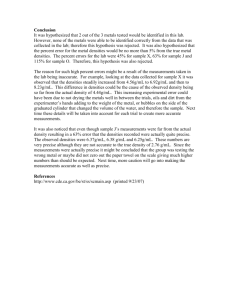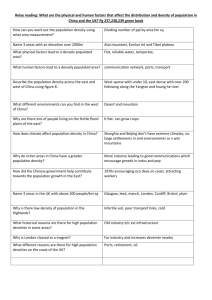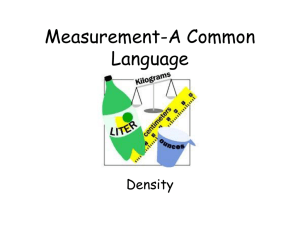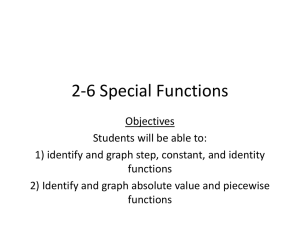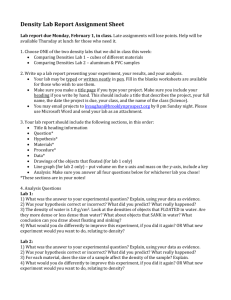Satyaki Mahalanabis Daniel Štefankovi Density estimation in linear time (+approximating L
advertisement
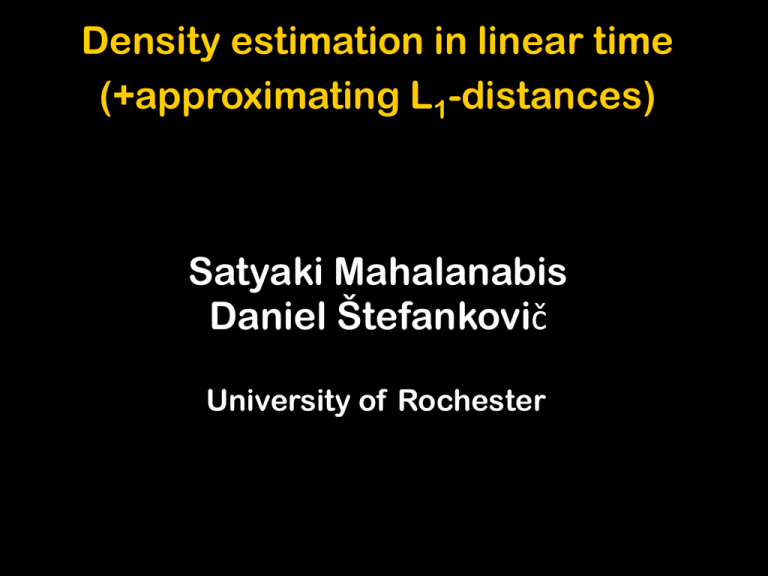
Density estimation in linear time
(+approximating L1-distances)
Satyaki Mahalanabis
Daniel Štefankovič
University of Rochester
Density estimation
f1
f3
f6
f2
f4
+ DATA
f5
F = a family of densities
density
Density estimation - example
N(,1)
+
F = a family of normal
densities with =1
0.418974,
0.848565,
1.73705,
1.59579,
-1.18767,
-1.05573,
-1.36625
Measure of quality:
g=TRUTH
f=OUTPUT
L1 – distance from the truth
|f-g|1 = |f(x)-g(x)| dx
Why L1?
1) small L1 all events estimated with
small additive error
2) scale invariant
Obstacles to “quality”:
F
+ DATA
bad data
weak class
of densities
dist1(g,F)
?
What is bad data ? | h-g |1
g = TRUTH
h = DATA (empirical density)
= 2max |h(A)-g(A)|
AY(F)
f1
f2
f3
Y(F) = Yatracos class of F
Aij={ x | fi(x)>fj(x) }
A12
A13
A23
Density estimation
F
+
DATA (h)
f with small |g-f|
assuming these are small:
dist1(g,F)
= 2max |h(A)-g(A)|
AY(F)
1
Why would these be small ???
dist1(h,F)
= 2max |h(A)-g(A)|
AY(F)
They will be if:
1) pick a large enough F
2) pick a small enough F
so that VC-dimension of Y(F) is small
3) data are iid from h
Theorem (Haussler,Dudley, Vapnik, Chervonenkis):
E[max|h(A)-g(A)|] VC(Y)
samples
AY
How to choose from 2 densities?
f1
f2
How to choose from 2 densities?
f1
+1
f2
+1 +1
-1
How to choose from 2 densities?
+1
Th
f2
+1 +1
f1
T f1
T f2
-1
T
How to choose from 2 densities?
f2
Th
f1
T f1
T f2
Scheffé:
if T h > T (f1+f2)/2 f1
else f2
Theorem
DL’01):
+1 +1(see
+1
-1
|f-g|1 3dist1(g,F) + 2
T
Density estimation
F
+
DATA (h)
f with small |g-f|
assuming these are small:
dist1(g,F)
= 2max |h(A)-g(A)|
AY(F)
1
Test functions
F={f1,f2,...,fN}
Tij (x) = sgn(fi(x) – fj(x))
Tij(fi – fj) = (fi-fj)sgn(fi-fj) = |fi – fj|1
Tijh
fj wins
Tijfj
fi wins
Tijfi
Density estimation algorithms
Scheffé tournament:
Pick the density with the most wins.
Theorem (DL’01):
|f-g|1 9dist1(g,F)+8
2
n
Minimum distance estimate (Y’85):
Output fk F that minimizes
max
|(f
-h)
T
|
k
ij
3
ij
Theorem (DL’01):
|f-g|1 3dist1(g,F)+2
n
Density estimation algorithms
Scheffé tournament:
Pick the density with the most wins.
Theorem (DL’01):
|f-g|1 9dist1(g,F)+8
2
n
Minimum distance estimate (Y’85):
Output
F that
minimizes
Can
wefkdo
better?
max
|(f
-h)
T
|
k
ij
3
ij
Theorem (DL’01):
|f-g|1 3dist1(g,F)+2
n
Our algorithm:
Efficient minimum loss-weight
repeat until one distribution left
1) pick the pair of distributions in F
that are furthest apart (in L1)
2) eliminate the loser
Theorem [MS’08]:
|f-g|1 3dist1(g,F)+2
n
*
Take the most “discriminative” action.
* after preprocessing F
Tournament revelation problem
INPUT:
a weighed undirected graph G
(wlog all edge-weights distinct)
OUTPUT:
REPORT: heaviest edge {u1,v1} in G
ADVERSARY eliminates u1 or v1 G1
REPORT: heaviest edge {u2,v2} in G1
ADVERSARY eliminates u2 or v2 G2
.....
OBJECTIVE:
minimize total time spent generating reports
Tournament revelation problem
A
report the heaviest edge
4
3
2
B
D
5
6
1
C
Tournament revelation problem
A
report the heaviest edge
4
3
BC
2
B
D
5
6
1
C
Tournament revelation problem
A
3
D
report the heaviest edge
BC
2
1
eliminate B
C
report the heaviest edge
Tournament revelation problem
A
3
D
report the heaviest edge
BC
2
1
eliminate B
C
report the heaviest edge
AD
Tournament revelation problem
report the heaviest edge
BC
eliminate B
D
1
C
report the heaviest edge
AD
eliminate A
report the heaviest edge
CD
Tournament revelation problem
A
B
4
3
2
D
6
1
C
AD
B
5
BC
C
BD
A
D
DC
AC
B
AD
2O(F) preprocessing O(F) run-time
O(F2 log F) preprocessing O(F2) run-time
WE DO NOT KNOW:
Can get O(F) run-time with
polynomial preprocessing ???
D
AB
Efficient minimum loss-weight
repeat until one distribution left
1) pick the pair of distributions that are
furthest apart (in L1)
2) eliminate the loser
(in practice 2) is more costly)
2O(F) preprocessing O(F) run-time
O(F2 log F) preprocessing O(F2) run-time
WE DO NOT KNOW:
Can get O(F) run-time with
polynomial preprocessing ???
Efficient minimum loss-weight
repeat until one distribution left
1) pick the pair of distributions that are
furthest apart (in L1)
2) eliminate the loser
Theorem:
|f-g|1 3dist1(g,F)+2
Proof:
n
“that guy lost even more badly!”
For every f’ to which f loses
|f-f’|1 max |f’-f’’|1
f’ loses to f’’
Proof:
“that guy lost even more badly!”
For every f’ to which f loses
|f-f’|1 max |f’-f’’|1
f’ loses to f’’
2hT23 f2T23 + f3T23
f1
(f1-f2)T12 (f2-f3) T23
(f4-h)T23
(fi-fj)(Tij-Tkl) 0
bad loss
f3
BEST=f2
|f1-g|1 3|f2-g|1+2
Application:
kernel density estimates
(Akaike’54,Parzen’62,Rosenblatt’56)
K = kernel
h = density
1
n
n
kernel used to smooth empirical g
(x1,x2,...,xn i.i.d. samples from h)
K(y-x )
i=1
=
g*K
i
as n
h*K
What K should we choose?
1
n
K(y-x )
n i=1
g*K
i
Dirac is not good
as n
h*K
Dirac would be good
Something in-between: bandwidth selection
for kernel density estimates
K(x/s)
as s 0
Ks(x)=
s
Ks(x) Dirac
Theorem (see DL’01): as s 0 with sn
|g*K – h|1 0
Data splitting methods for
kernel density estimates
How to pick the smoothing factor ?
n
1
y-xi
K
ns
s
i=1
(
x1,...,xn-m
x1,x2,...,xn
xn-m+1,...,xn
)
1
fs =
(n-m)s
n-m
K(
i=1
y-xi
s
choose s using
density estimation
)
Kernels we will use:
1
ns
K(
y-xi
s
)
piecewise uniform
piecewise linear
Bandwidth selection for uniform
1/2
E.g.
N
n
kernels
5/4
mn
N distributions
each is piecewise uniform with n pieces
m datapoints
Goal: run the density estimation algorithm efficiently
TIME
MD
EMLW
gTij
(fi+fj)Tij
2
n+m log n
(fk-h) Tkj
n+m log n
|fi-fj|1
n
N
N2
N2
Bandwidth selection for uniform
1/2
E.g.
N
n
kernels
5/4
Can speed m n
N distributions
this
up?
each is piecewise uniform with n pieces
m datapoints
Goal: run the density estimation algorithm efficiently
TIME
MD
EMLW
gTij
(fi+fj)Tij
2
n+m log n
(fk-h) Tkj
n+m log n
|fi-fj|1
n
N
N2
N2
Bandwidth selection for uniform
1/2
E.g.
N
n
kernels
5/4
Can speed m n
N distributions
this
up?
each is piecewise uniform with n pieces
absolute error bad
Goal: run the density estimation algorithm efficiently
relative
error
good
TIME
MD
EMLW
m datapoints
gTij
(fi+fj)Tij
2
n+m log n
(fk-h) Tkj
n+m log n
|fi-fj|1
n
N
N2
N2
Approximating L1-distances
between distributions
N piecewise uniform densities (each n pieces)
(N2+Nn) (log N)
WE WILL DO:
2
TRIVIAL (exact): N2n
Dimension reduction for L2
Johnson-Lindenstrauss Lemma (’82)
: L2 Lt2
|S|=n
t = O(-2 ln n)
( x,y S)
d(x,y) d((x),(y)) (1+)d(x,y)
N(0,t-1/2)
Dimension reduction for L1
Cauchy Random Projection (Indyk’00)
: L1 Lt1
|S|=n
t = O(-2 ln n)
( x,y S)
d(x,y) est((x),(y)) (1+)d(x,y)
-1/2)
C(0,1/t)
N(0,t
(Charikar, Brinkman’03 : cannot replace est by d)
Cauchy distribution C(0,1)
density function:
1
(1+x2)
FACTS:
XC(0,1)
aXC(0,|a|)
XC(0,a), YC(0,b)
X+YC(0,a+b)
Cauchy random projection for L1
(Indyk’00)
A
X1
X2
B
D
X3 X4 X5 X6 X7 X8 X9
X1C(0,z)
A(X2+X3) + B(X5+X6+X7+X8)
z
Cauchy random projection for L1
(Indyk’00)
A
X1
z
X2
B
D
X3 X4 X5 X6 X7 X8 X9
X1C(0,z)
A(X2+X3) + B(X5+X6+X7+X8)
D(X1+X2+...+X8+X9)
Cauchy(0,|-|1)
All pairs L1-distances
piece-wise linear densities
All pairs L1-distances
piece-wise linear densities
R=(3/4)X1 + (1/4)X2
B=(3/4)X2 + (1/4)X1
R-BC(0,1/2)
X1
X2
C(0,1/2)
All pairs L1-distances
piece-wise linear densities
Problem: too many intersections!
Solution: cut into even smaller pieces!
Stochastic measures are useful.
1.0
Brownian motion
0.5
1
0.2
0.4
0.6
0.8
1.0
exp(-x^2/2)
(2)1/2
0.5
Cauchy motion
0.4
1
0.2
0.2
0.2
0.4
0.4
0.6
0.8
1.0
(1+x)2
1.0
Brownian motion
0.5
1
0.2
0.4
0.6
0.8
1.0
exp(-x^2/2)
(2)1/2
0.5
computing integrals is easy
f:RRd
f dL = Y N(0,S)
0.4
Cauchy motion
0.2
1
0.2
0.4
0.6
0.8
1.0
(1+x)2
0.2
0.4
computing integrals is easy
f:RRd
f dL = Y C(0,s) for d=1
computing integrals is hard d>1
*
* obtaining explicit expression for the density
X1
X2
X3 X4 X5 X6 X7 X8 X9
What were we doing?
(f1,f2,f3) dL = (w1)1,(w2)1,(w3)1
X1
X2
X3 X4 X5 X6 X7 X8 X9
What were we doing?
(f1,f2,f3) dL = (w1)1,(w2)1,(w3)1
Can we efficiently compute
integrals dL for piecewise linear?
Can we efficiently compute
integrals dL for piecewise linear?
: R R2
(z)=(1,z)
(X,Y)= dL
: R
(z)=(1,z)
2
R
(X,Y)= dL
u+v,u-v
(2(X-Y),2Y) has density at
2
All pairs L1-distances for mixtures of
uniform densities in time
(N^2+Nn) (log N)
2
O(
)
All pairs L1-distances for piecewise
linear densities in time
(N^2+Nn) (log N)
2
O(
)
QUESTIONS
: R R3
2)
(z)=(1,z,z
1)
(X,Y,Z)= dL
?
2) higher dimensions ?




